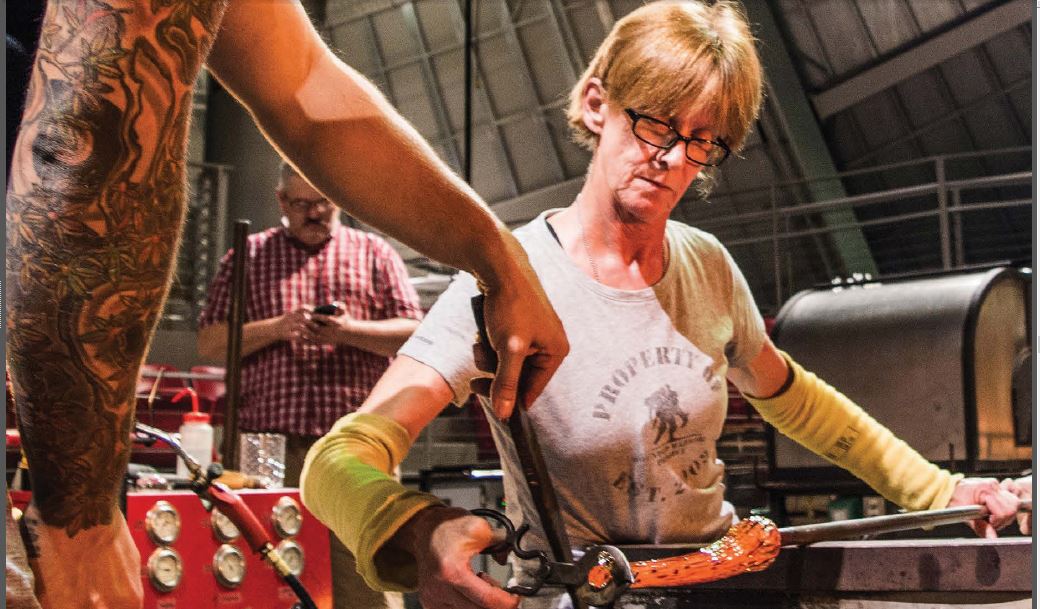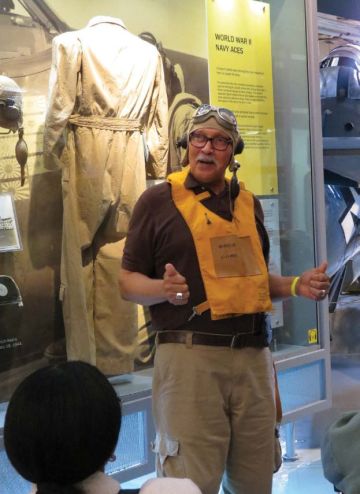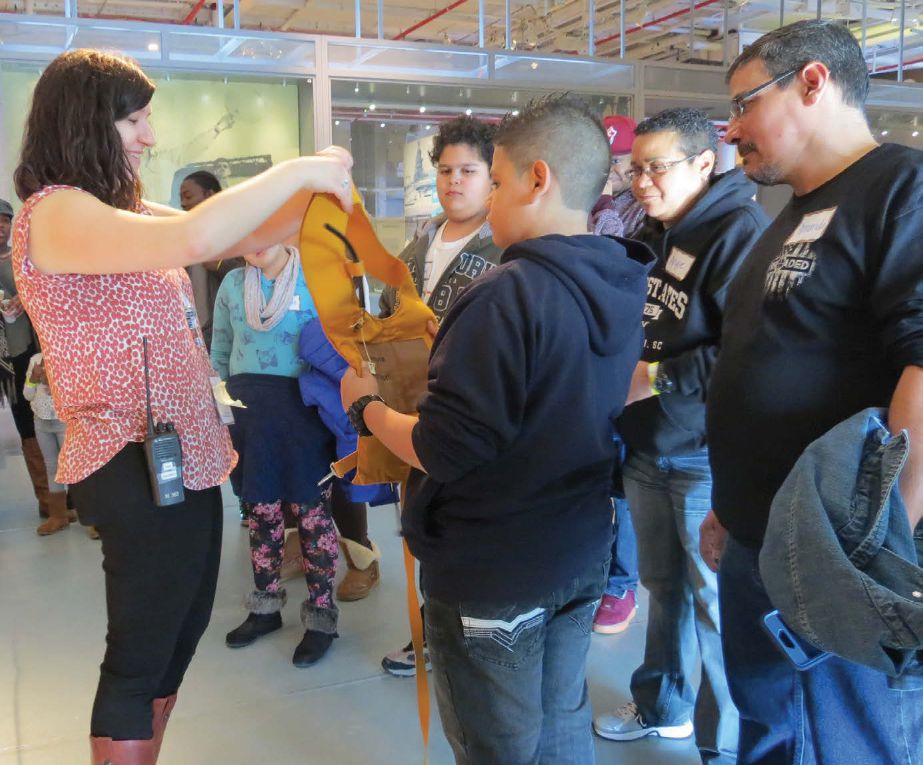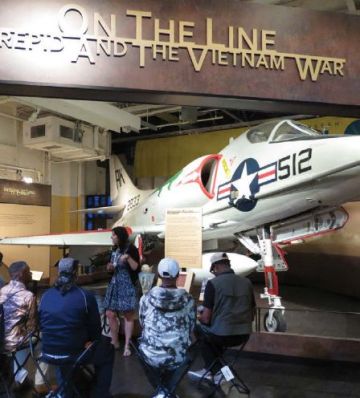
This article originally appeared in the July/August 2017 issue of Museum magazine.
Museums are uniquely suited to build confidence, comfort, and community for veterans.
Approximately 21.5 million veterans live in the United States. As they reintegrate into civilian life, many service members face significant challenges that affect daily routines and personal relationships. While it is important not to generalize their experiences, many veterans must cope with an often jarring transition, leaving behind challenging roles in the military community for an unregimented civilian world in which few understand their experiences and sacrifices. And of the more than two million American troops that have deployed to Iraq and Afghanistan since 2001, nearly a third have reported symptoms of post-traumatic stress (PTS), depression, or traumatic brain injury (TBI). As community-based institutions, museums of any discipline are well-positioned to serve veterans and provide opportunities that teach new skills, create space for dialogue, and encourage connections to history and art. Programming for veterans reflects a wider trend in museum education toward better acknowledging and catering to mental health needs, and it builds upon longstanding connections between the military, the arts, and culture.
The Intrepid Sea, Air & Space Museum in New York City, the Philadelphia Museum of Art, and the Museum of Glass in Tacoma, Washington offer programs specifically designed with and for veterans. Participants attend these programs for a variety of reasons—some come for personal healing, others come so that they can experience a sense of community. Still, others participate because they are interested in learning more about that topic or the museum. In all cases, each program illustrates examples and lessons that can be adopted by any museum seeking to engage members of the military community and have meaningful impact on the lives of veterans.

Intrepid Sea, Air & Space Museum
Centered on the aircraft carrier Intrepid, a National Historic Landmark, the Intrepid Sea, Air & Space Museum promotes the awareness and understanding of history, science, and service to honor heroes, educate the public, and inspire youth. Building upon its robust programming for diverse communities, the museum’s education department developed the Veterans Access Initiative in the fall of 2015. The initiative stemmed from a desire to better serve and expand the diverse audiences of its educational programs, and offer a potential model for any museum looking to do the same. The Veterans Access Initiative has three key programs: Military Family Programs, Intrepid After Hours, and Vet Video Chats (launching this year). Together, these programs aim to provide a comfortable and welcoming environment for families and veterans. The initiative is fully funded to remove financial barriers for participation and ensure dedicated resources for staff training.
Military Family Programs, for service members and their children ages 3–17, consist of hands-on activities and multisensory tours led by educators. The museum provides refreshments beforehand, offering families a chance to get to know one another. During the tour, participants explore different parts of the ship and share their own stories. When possible, the museum also invites special guests, such as former crew members of Intrepid, who provide personal narratives and answer questions during the activities portion of the program. Some of the most meaningful moments are when a service member relates to a historic story or space and is able to share that moment with family.
Intrepid After Hours is only for service members. It consists of self-guided exploration, a creative workshop or tour, and a catered dinner. The program takes place after museum hours, which minimizes potentially triggering sensory experiences and allows participants to explore the museum free of crowds. The workshop might include behind-the-scenes tours or guided lessons with outside organizations. The communal meal gives participants a chance to relax and converse and allows the museum to show its appreciation for their service. Each program provides a unique opportunity for creative expression and storytelling, and many participants return again and again. The staff has partnered with outside organizations to lead some of the workshops. Past partners include the Bedlam Theater Company, which connects service members to theater through classic texts, and Voices from War, which leads writing workshops for veterans. In both cases, the organizations gave participants an opportunity to try a potentially new form of creative engagement without a long-term commitment. Partnering with outside organizations also creates a mutually beneficial exchange: the teaching artists introduce their programming to new audiences, and the museum offers new experiences that build upon its collection and spaces. The Bedlam workshop, for example, took place in the Exploreum, a large hall on the hangar deck, and activated the space in a new way. By showcasing the history of Intrepid and other elements of the collection, the programs demonstrate the value of preserving and sharing history—showing participants that their stories are also worth sharing. This encourages veterans to share their own experiences, leading to a meaningful discussion about the difficulties of returning to civilian life and the personal artifacts that people have held onto.
For veterans unable to visit the museum, Vet Video Chats build social connections and provide stimulating conversations. This online program highlights objects and spaces within the museum and invites individuals to ask questions, make comments, and share stories. It will especially enrich the lives of individuals who require intensive healthcare services at home or in a hospital setting.

Philadelphia Museum of Art.
Philadelphia Museum of Art
The Philadelphia Museum of Art offers gallery tours and art-making workshops for veteran groups through its Veterans Empowered Through Art (V.E.T. Art) program. The program launched in the summer of 2014, with a focus group of veterans from the Veteran Empowerment Center (VEC) at the nearby Veterans Administration (VA) facility. The VEC is a psychosocial rehabilitation and recovery center that emphasizes quality of life for veterans with various mental illnesses, including PTS. Over the course of a year, the original focus group of 8-10 male veterans and their clinical nurse specialist took tours of the museum galleries. After each tour, the group engaged in casual roundtable discussion about the artwork. These discussions were the most revealing part about the day, because the veterans would open up about the feelings they were having, something they didn’t think would happen when looking at art. Nearly all the veterans indicated they initially did not want to look at anything that would remind them of war. But after several visits, one of the veterans said: “you know, the more I come here, the more relaxed I get.” This was a big breakthrough for this individual. Many of the Veterans experienced similar breakthroughs throughout this experience. After a year of tours, the veterans in the focus group decided what they would include on future tours with new groups, and came up with the name of the program.
Now, four members of the focus group come back to discuss with new groups why they chose the art they did. They speak in front of people, express why they love the art in the museum, and describe the impact that the art and this program has had on their lives. Working with museum educators to develop and co-lead tours is significant because many of these men at one time had such severe PTS that they couldn’t leave their homes. The focus group’s knowledge of the museum’s collection, longstanding connections to the education team, and deep understanding of the military experience allow them to develop tours that speak to service members’ interests while avoiding potentially triggering images or topics.
The V.E.T Art program also includes art lessons with a teaching artist who specializes in teaching beginners visual literacy skills that enable students to make a significant leap in their ability in a very short time. As a result of these lessons, the veterans learn how to view objects from different perspectives, and how to see things three-dimensionally. This three-dimensional thinking improves their drawing ability, and it becomes a powerful impetus for asking original questions and visualizing new approaches. In addition, these classes are fun, encouraging camaraderie that enables the veterans to go beyond self-imposed limitations. The museum also collaborates with a group of women veterans from the VEC (we have different groups for men and women because typically the VA in Philadelphia separates their groups in this way).
We are continuing our partnership with the VEC by offering additional art-making workshops, guided tours of special exhibitions, and piloting new programs. One such program is a six-week self-portrait and creative writing series, in which participants observe themselves closely and, as their skills improve, start to see themselves differently and discover things about themselves (both physical and emotional) they may not have realized before. This six-week experience is being documented in an exhibition this summer at Philadelphia City Hall.
As the V.E.T. Art program grows, we plan to train new veteran guides to add to the guide pool. The program’s success is due in large part to the fact that the veterans were so involved with its creation. The partnerships we have created with these veterans have inspired trust and friendship that is evident to newcomers. This carries a lot of weight in the veteran community. When new groups see our veteran guides empowered by the art around them, they see that it is possible to be empowered by this experience too.
Museum of Glass
Museum of Glass (MOG) in Tacoma, Washington, offers eight-week glassblowing courses four times a year, after hours, for soldiers and veterans. In MOG’s Hot Shop Heroes classes, students learn the basics of glassblowing from skilled glass instructors, and create their own pieces, working toward larger-scale group designs. The idea for the program emerged in 2013 from a special free day at the museum for members of the military and their families sponsored by renowned glass artist Dale Chihuly. The day was such a success that MOG embarked on a partnership with the nearby Army/Air Force base, Joint Base Lewis-McChord (JBLM). Leaders from the Army base and the museum saw a need to better serve soldiers in the Warrior Transition Battalion (WTB), all of whom are undergoing medical and/or psychological treatment at JBLM and will not be returning to active duty. While the soldiers may be in the WTB for a variety of reasons, many are being treated for TBI and other critical injuries, and are all going through an uncertain transition process back to civilian life. MOG realized early on that most of the people we were working within the program had PTS to some degree, and would respond best to a structured environment and glass instructors who would be patient and sensitive to their unique needs.

To meet the needs of this audience, the museum designed courses that capitalize on the inherent therapeutic qualities of glassblowing while providing the opportunity to build collaborative skills in a civilian context. Each course provides one instructor for every three students, with a total of twelve students and four instructors. Equally important to the student-teacher ratio, each class begins with a communal meal, to give everyone time to relax, enjoy each other’s company, and build camaraderie. MOG considers this shared meal one of the secrets to the success of the Hot Shop Heroes.
In late 2014, the curatorial department of MOG suggested the idea of an exhibition of work made by the soldiers. The resulting exhibition, “Healing in Flames,” amazed us all when it opened in 2015. What the administration imagined would be a shaky collection of crooked cups and sagging bowls became one of the most deeply moving exhibits the museum has ever mounted. It quickly became apparent that the pieces were extremely personal statements of great effort, loss, and acceptance. The exhibition opening was unlike any event seen before at the museum, with top military brass mingling with artists, politicians, and arts administrators from across the country. The opening also helped foster the National Endowment for the Arts’ (NEA) interest in Hot Shop Heroes as a useful model for addressing TBI and PTS; the NEA encouraged the museum to apply for an operational grant, which was awarded in 2015. Through this grant, MOG is learning more about other art therapy and art-as-therapy programs serving this unique audience. Today, the Hot Shop Heroes program is generally split half and half between members of the WTB and other veterans from the community, allowing for connections across generations and branches of service.
Ultimately, it is the intense focus required to keep the 2,000-degree blob of glass on the end of the blowpipe that is the greatest gift we can offer our veterans and soldiers. Veterans tell us the three hours of class time is the only period in the week when they can forget about their troubles and train their mind on something creative. One explosives specialist summed it up by saying “in the Army, I was trained to destroy things, while Hot Shop Heroes has given me a chance to create something new.” Hot Shop Heroes began with a simple goal of offering people in a rough situation a chance to try a new activity with a new group of people. No one at the museum knew what good fit soldiers and glassblowing would be. It turns out that soldiers take directions very well, they work excellently as a team, and perhaps most importantly, they are adept at working in dangerous situations—a perfect combination for being a glassblower.

Factors to Success in Programming
Build upon the museum’s strengths. Where possible, use and rework established program models, building upon the success of those programs and applying resources and knowledge to a new audience. Museums of any discipline can leverage their strengths and make creative connections to their collections.
Think about the target audience. Military service members form a diverse community. When planning any program, be thoughtful in the use of language. “Veteran” can be an exclusive term, with varying definitions across the spectrum of military experiences. Furthermore, veterans with PTS or TBI represent a minority of service members, and stigma may prevent individuals from self-identifying. If this group is the intended audience, then partnerships with outside organizations and targeted outreach may be a more effective way of reaching them than a public program model. Above all, building trust and rapport will contribute to the comfort veterans feel within the museum.
Seek out training. Appropriate staff training is essential to better understand military culture as well as veterans with PTS and TBI. Invest time and effort in building relationships and partnerships with veteran service organizations in your area. Offer all-staff training for museum leaders and educators; these trainings can offer suggestions for working with veterans and increasing comfort in exhibitions and the museum in general. Following these suggestions, your staff may create additional supports for veterans, including concrete language and a floor plan of exhibitions, which can warn visitors of potentially emotionally sensitive elements.
Incorporate service members as voices of authority. Incorporate service members into the development, leadership, and delivery of programs. To do so, seek out partnerships with organizations that are focused on or led by veterans and that have an established track record of working with military communities. This involvement shows participants that the program leaders know there are certain experiences they as civilians will never understand. It also helps to break down barriers, encourages personal conversation, and demonstrates respect.
Establish a friendly atmosphere. The challenges of returning to civilian life after military service are complex and consuming. Upon leaving the military, veterans can experience feelings of isolation, loss of purpose, and lack of understanding from their civilian peers. The programming and experiences offered by museums are uniquely suited to building confidence, comfort, and community. Consider name tags, informal discussions, refreshments, and communal meals. Cultural institutions can use preexisting resources and build partnerships to reach wider audiences of military service members as they offer necessary opportunities for community building and personal growth.
Does your museum serve veterans and military service members? AAM is preparing a special report on the many ways museums serve veterans, military service members, and their families. Tell us about your programs, events, initiatives, or special offers for those who serve and sacrifice for our nation at http://bit.ly/AAMMuseumsServe.
Sara Lowenburg is museum educator for access programs at the Intrepid Sea, Air & Space Museum in New York City. Marissa Clark is accessible programs coordinator at the Philadelphia Museum of Art. Greg Owen is Hot Shop Heroes manager at the Museum of Glass in Tacoma, Washington. This article is adapted from their session held during the 2017 AAM Annual Meeting & MuseumExpo.








